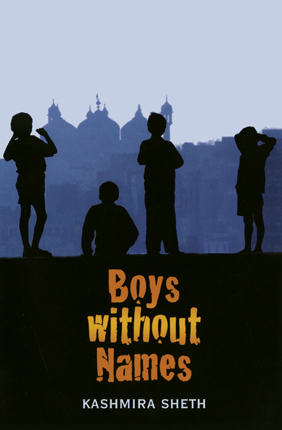Full Text Reviews: Booklist - 11/15/2009 Set in contemporary Mumbai, this novel from the author of Keeping Corner (2007) tells a harrowing story of child slavery. Indebted to ruthless moneylenders, 11-year-old Gopal’s family flees to Mumbai, where they hope to find work. On the way, Gopal’s father goes missing, and Gopal guides his mother and siblings to an uncle’s house, where they worry and wait for Baba to find them. Eager to help his family earn money, Gopal follows a local boy to what he thinks will be a day’s work at a factory. Instead, he is pulled into a sweatshop—a single room where five boys are held against their will and forced to produce decorative items with toxic materials. As Gopal dreams of escape, he builds tenuous friendships with his fellow workers. Those wary bonds form a dramatic counterpoint to the children’s daily misery, described in moving, palpable detail, and skillfully steer the story away from docu-novel territory to its hopeful conclusion. Pair this eye-opening title with Susan Kuklin’s Iqbal Masih and the Crusaders against Child Slavery (1998). - Copyright 2009 Booklist. School Library Journal - 01/01/2010 Gr 4–7— Eager to find work after his hungry family arrives in Mumbai, 11-year-old Gopal ends up locked in a one-room "factory" making beaded frames with five other boys so beaten down they don't even talk to one another. Gopal's story is not uncommon: a bumper crop year drove prices down, money was borrowed to pay for medicine, the farm was lost but the debt remained, and the family was forced to flee to the city to find work. Gopal stores up his memories of his rural Indian village, with its pond, fruit trees, and bird songs, contrasting them with the noisy stink of their new home at the end of a sewage-laden lane in an overcrowded shantytown. Readers quickly come to care for this clever, perceptive boy who tries hard to do the right thing. Suspense mounts as it becomes clear that escape from the sweatshop will not be easy: the other boys need to be convinced. Storytelling is the key to winning them over, and Sheth includes bits of tales both familiar and new. The author includes more about child labor at the end of this well-told survival story with a social conscience.—Kathleen Isaacs, Children's Literature Specialist, Pasadena, MD - Copyright 2010 Publishers Weekly, Library Journal and/or School Library Journal used with permission. Bulletin for the Center... - 03/01/2010 Burdened with medical costs, the family of eleven-year-old Gopal must flee the money collector in their small Indian village in hope of finding a better life in Mumbai. Shortly after they arrive in the city, Gopal’s father disappears; determined to help his struggling family, Gopal seeks work but finds himself abducted into virtual slavery, working in a sweatshop alongside other captive children. This fictional exposé is based upon Sheth’s many interviews with Indian kids in child labor and with organizations in India seeking to help such children, and the details offered of day-to-day life in the sweatshop are harrowing: the boys are essentially starved to death, refused medicine, beaten when their work is deemed inadequate, and forbidden to speak to one another during the long, hot days. Gopal differs from the other boys in possessing a family and a basic education, and in time his leadership draws the group together through the telling of kahanis, or stories, both personal and folkloric. The dynamics among the boys are intriguing, with leadership changing hands, lies being used strategically, stories both dividing and uniting, and alliances constantly shifting. The story starts slowly, but once Gopal arrives at the factory, the pacing is fast and the characterization strong. Gopal’s inner monologue is sincere and reflective, and the necessity of holding tight to your imagination when it’s your only salvation is presented with conviction and sincerity. This is a strong work of contemporary fiction that offers young readers an authentic glimpse into a world very different from what they may know; it could also partner effectively with nonfiction works on the problem of forced child labor such as Susan Kuklin’s Iqbal Masih and the Crusaders against Child Slavery (BCCB 11/98). HM - Copyright 2010 The Board of Trustees of the University of Illinois. Loading...
|



